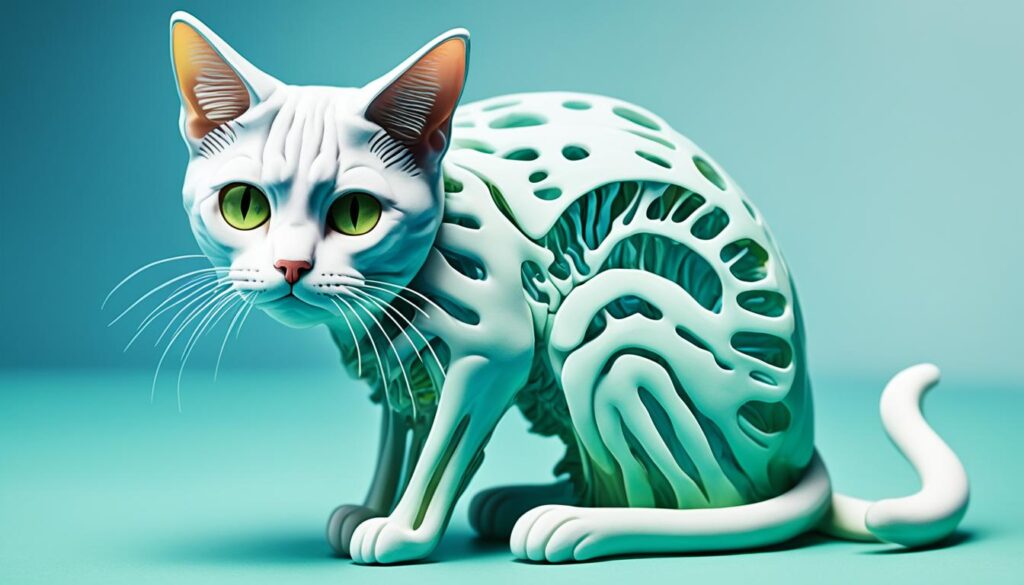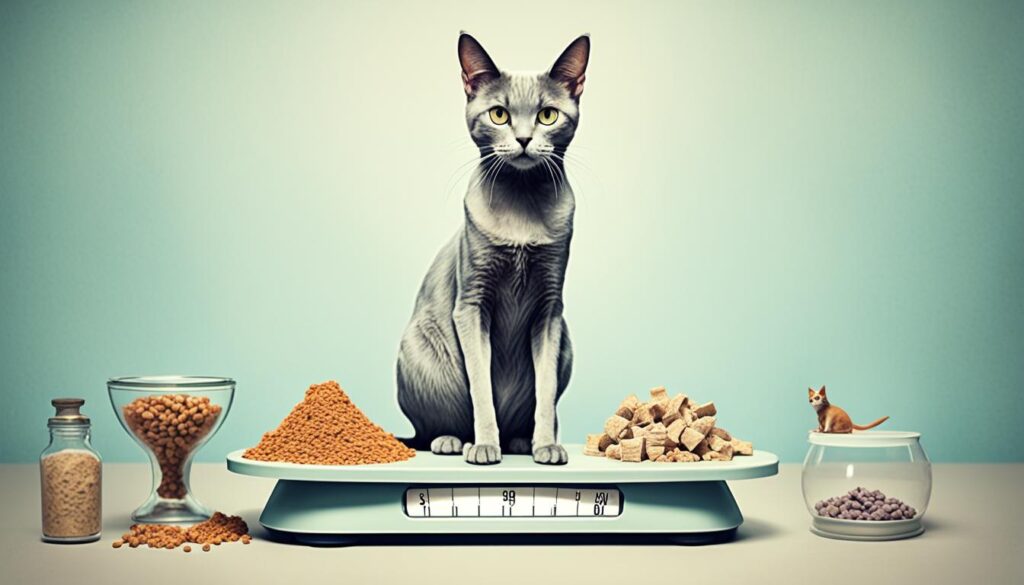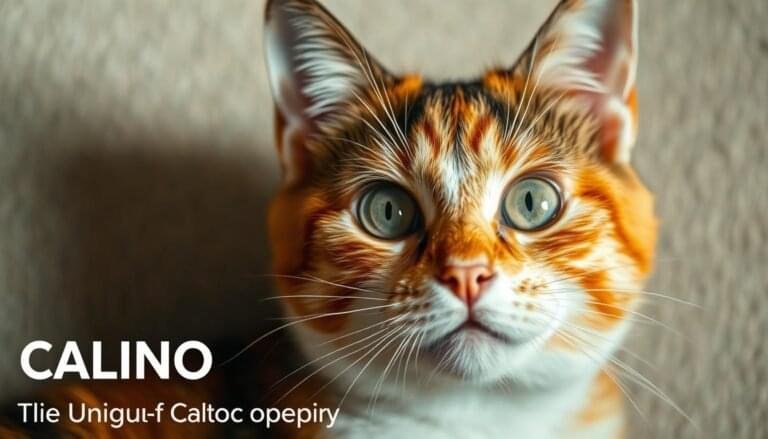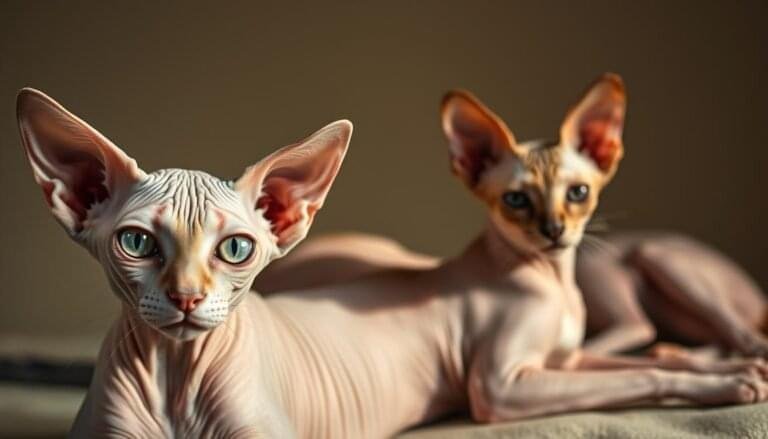Cat Losing Weight: Did you know that unintentional weight loss in cats can be a cause for concern, especially in senior cats? It’s true – when your feline friend starts shedding pounds without any apparent reason, it could be a sign of an underlying health issue. With proper understanding and timely intervention, you can help your cat regain a healthy weight and improve their overall well-being.
Key Takeaways:
- Unintentional weight loss in cats can be indicative of an underlying health issue, especially in senior cats.
- Common causes of weight loss in cats include insufficient food intake, intestinal parasites, feline diabetes, feline hyperthyroidism, feline viral diseases, feline kidney disease, and feline cancer.
- Consulting a veterinarian is crucial to determine the cause and appropriate treatment for weight loss in cats.
- Addressing factors such as obstructed access to food, parasitic infestations, and underlying medical conditions can help in managing your cat’s weight loss.
- Regular vet visits and proactive weight management are essential for the long-term health of your cat.
Not Getting Enough Food
Cats may lose weight if they are not getting enough food. There are various factors that can contribute to insufficient food intake in cats, leading to weight loss.
Presence of Other Pets
If there are other pets in the house, your cat may feel stressed or anxious during mealtime. This can disrupt their eating patterns and cause a decrease in food intake. It’s essential to create a calm and quiet environment for your cat during meals to ensure they feel comfortable and secure.
Change in Food Brand
Introducing a new food brand or recipe abruptly can result in your cat refusing to eat. Cats can be quite selective about their food preferences, and sudden changes can be met with resistance. Gradually transitioning to a new food brand can help mitigate this issue and prevent a decrease in food intake.
Obstructed Access to Food
Cats with arthritis pain or physical limitations may find it challenging to access their food dish. Jumping onto countertops or climbing stairs to reach the food can become painful and uncomfortable. Ensuring that the food dish is easily accessible without any obstacles can encourage your cat to eat without experiencing pain or discomfort.
To cater to cats with arthritis pain or physical limitations, consider providing raised food dishes or placing food bowls in easily reachable locations. This can help alleviate any challenges they may face while attempting to eat.
Cat’s Eating Environment
Anxiety or stress in the eating environment can significantly impact a cat’s food intake. Loud noises, crowded spaces, or changes in the household routine can make cats feel uneasy and cause them to lose interest in eating. It’s important to provide a calm and peaceful environment for your cat during mealtime.
Creating a designated feeding area away from household commotion can ensure that your cat feels safe and comfortable while eating.
Example Table:
| Factors Impacting Food Intake | Potential Consequences |
|---|---|
| Presence of other pets in the house | Increased stress and anxiety during meals |
| Change in food brand | Refusal to eat due to unfamiliar taste or texture |
| Obstructed access to food | Pain or discomfort while reaching the food dish |
| Anxiety or stress in the eating environment | Loss of appetite due to an uneasy environment |
Ensuring that your cat has uninterrupted access to food and a stress-free eating environment can help prevent weight loss due to insufficient food intake. Additionally, consulting with your veterinarian can provide further guidance on addressing any specific issues your cat may be facing.
Intestinal Parasites
Cat parasites, such as worms, can lead to weight loss in felines. These parasites can be contracted when cats hunt or ingest fleas, or when they come into contact with contaminated environments. To diagnose the presence of intestinal parasites, a fecal exam is necessary. Once diagnosed, deworming medications can be administered to eliminate the parasites and restore the cat’s weight.
Intestinal parasites are a common issue among cats and can cause various health problems if left untreated. It’s essential to understand the signs and symptoms of worm infestation and take appropriate measures to ensure the well-being of your furry companion.
If you suspect your cat may have parasites, consult your veterinarian for a thorough examination. They may recommend a fecal exam to identify the specific parasite species and determine the appropriate deworming treatment. Deworming not only helps your cat regain lost weight but also prevents the parasites from causing further harm.
Deworming Medications
Deworming medications for cats are available in various forms, including tablets, topical treatments, and injections. The specific medication prescribed will depend on the type of parasite and the severity of infestation. It’s important to follow your veterinarian’s instructions and complete the full course of treatment to ensure the parasites are completely eradicated.
Here is a table detailing common deworming medications for cats:
| Medication | Method of Administration | Recommended Frequency |
|---|---|---|
| Pyrantel Pamoate | Oral (tablet or liquid) | Every 2 weeks for 2-3 doses, then as needed |
| Fenbendazole | Oral (tablet or paste) | Once daily for 3-5 consecutive days |
| Selamectin | Topical (spot-on solution) | Once monthly, year-round |
| Praziquantel | Oral (tablet or liquid) | Varies depending on specific parasite |
Feline Diabetes
Feline diabetes is a common condition that can cause weight loss in cats. If you notice your cat experiencing unexplained weight loss, it’s important to consider feline diabetes as a potential cause.
One of the key symptoms of feline diabetes is increased thirst. Cats with diabetes may drink more water than usual due to the body’s inability to regulate blood sugar levels effectively.
Another common symptom is increased urination. Cats with diabetes may produce larger amounts of urine or need to use the litter box more frequently than usual.
Treatment for feline diabetes typically involves diet changes and insulin administration. A veterinarian will create a personalized diet plan for your cat, focusing on low-carbohydrate, high-protein options that help regulate blood sugar levels.
Sample Diet Plan for Cats with Diabetes:
| Meal | Food |
|---|---|
| Breakfast | 2 tablespoons of canned chicken mixed with a small amount of low-carbohydrate wet food |
| Lunch | 1/4 cup of prescription diabetic dry kibble |
| Dinner | 2 tablespoons of canned tuna in water |
In addition to diet changes, cats with diabetes may require insulin injections. Insulin helps regulate blood sugar levels and can be administered at home under the guidance of a veterinarian.
If you suspect your cat may have diabetes, it’s important to seek immediate veterinary care. Early diagnosis and treatment can significantly improve your cat’s quality of life and help manage their weight effectively.
Feline Hyperthyroidism
Feline hyperthyroidism is a condition characterized by an overactive thyroid gland, resulting in increased metabolism and weight loss in cats. This hormonal imbalance can have a significant impact on their overall health and well-being. Cats with hyperthyroidism may also exhibit an increased appetite.
The symptoms of feline hyperthyroidism can vary, but weight loss is one of the most common indicators. Due to the increased metabolism, cats with hyperthyroidism often burn calories at a faster rate, leading to unintentional weight loss despite consuming more food. Other symptoms may include increased thirst, increased urination, and a rapid heart rate.
Diagnosing feline hyperthyroidism requires a thorough veterinary evaluation. Your veterinarian may perform blood tests to measure thyroid hormone levels. In some cases, additional diagnostic imaging such as ultrasound or scintigraphy may be necessary to confirm the diagnosis.
Treatment options for feline hyperthyroidism include medication, special diets, or radioactive iodine treatment. Medications can help regulate thyroid hormone levels and manage the symptoms of hyperthyroidism. Special diets formulated to support thyroid health may also be recommended. In some cases, radioactive iodine treatment may be necessary to remove or destroy the overactive thyroid tissue.
It’s important to work closely with your veterinarian to determine the most appropriate treatment plan for your cat. Regular monitoring through follow-up appointments and blood tests is essential to ensure that the treatment is effectively managing the condition and the cat’s weight stabilizes.
Treatment Options for Feline Hyperthyroidism
| Treatment Option | Description |
|---|---|
| Medication | Oral or transdermal medication to regulate thyroid hormone levels. |
| Special Diets | Dietary formulations designed to support thyroid health. |
| Radioactive Iodine Treatment | Procedure to remove or destroy overactive thyroid tissue. |
Feline Viral Disease
Feline viral diseases, such as FIP, FeLV, and FIV, are viral infections that can cause weight loss in cats. Weight loss is a common symptom of these viral diseases and should be taken seriously as it may indicate the progression of the condition.
Diagnosis and treatment of feline viral diseases depend on the specific virus involved and the symptoms exhibited by the cat. Veterinary evaluation is necessary to determine the appropriate management and treatment plan.
Common Feline Viral Diseases
There are several common viral diseases that can lead to weight loss in cats:
- Feline Infectious Peritonitis (FIP): FIP is a viral disease caused by a coronavirus. It can affect various organs, including the liver, kidneys, and intestines. Weight loss, along with other symptoms such as fever and fluid accumulation in the abdomen, may be seen in cats with FIP.
- Feline Leukemia Virus (FeLV): FeLV is a viral disease that weakens the immune system, making cats susceptible to various infections and diseases. Weight loss is a common symptom of FeLV, along with anemia and recurrent infections.
- Feline Immunodeficiency Virus (FIV): FIV is similar to HIV in humans and weakens the immune system, making cats more susceptible to infections. Weight loss is often observed in cats with FIV, along with poor coat condition and recurrent infections.
Management and Treatment
Managing feline viral diseases involves supportive care and addressing the cat’s specific symptoms. Although there is no cure for FIP, FeLV, or FIV, various treatment options can help improve the cat’s quality of life and slow down the disease progression:
- Providing a balanced and nutritious diet to support the cat’s immune system and maintain weight.
- Administering medication to manage specific symptoms or complications.
- Regular veterinary check-ups to monitor the cat’s condition and adjust the treatment plan as needed.
- Preventing the spread of viral diseases to other cats through proper isolation and vaccination.
It’s important to note that each feline viral disease has its unique challenges and treatment protocols. Therefore, early detection, accurate diagnosis, and personalized care are essential for managing weight loss and improving the overall well-being of cats affected by these viral diseases.
Feline Kidney Disease

Feline kidney disease is a condition that can significantly impact a cat’s health and well-being. In addition to causing weight loss, it is often characterized by symptoms such as increased thirst, increased urination, and lethargy. Recognizing the signs and seeking prompt veterinary care is essential for managing this condition effectively.
Diagnosing feline kidney disease typically involves conducting blood work and urinalysis. These tests help evaluate kidney function and identify any abnormalities. By examining the levels of certain substances in the blood and urine, veterinarians can diagnose kidney disease and determine the appropriate treatment plan.
The treatment approach for feline kidney disease may vary based on the stage and severity of the condition. In some cases, dietary changes, such as prescription food formulated to support renal health, can be beneficial. Medications may also be prescribed to manage symptoms and slow down the progression of the disease.
Early intervention is crucial when it comes to kidney disease in cats. While this condition is progressive and incurable, early detection and treatment can help improve a cat’s quality of life and slow down the disease’s progression. Regular monitoring and follow-up appointments with a veterinarian are essential for managing feline kidney disease.
Here is a table summarizing the diagnostic tests used for feline kidney disease:
| Diagnostic Test | Description |
|---|---|
| Blood Work | Evaluates kidney function by measuring various markers in the blood, such as blood urea nitrogen (BUN) and creatinine levels. |
| Urinalysis | Examines the urine for abnormalities, such as the presence of protein or red blood cells, which can indicate kidney damage. |
Feline Cancer
Various forms of cancer can cause weight loss in cats. When a cat is losing weight unexpectedly, it is essential to consider the possibility of feline cancer. The diagnosis and treatment of feline cancer depend on the type and stage of the disease. To properly diagnose cancer in cats, veterinarians may perform a series of diagnostic tests.
Diagnosis
When cancer is suspected, veterinarians often start with a comprehensive examination and take into account the cat’s medical history. However, definitive diagnosis requires specific tests such as blood work, X-rays, ultrasounds, and biopsies. These tests help determine the location, extent, and type of cancer present in the cat’s body.
Treatment Options
The treatment for feline cancer varies based on the type and stage of the disease. Common treatment options include:
- Surgery: In cases where the cancer is localized, surgery may be recommended to remove the tumor. This can be curative or provide palliative relief.
- Chemotherapy: Chemotherapy may be prescribed to control the growth and spread of cancer cells. It can be used as the primary treatment or in combination with other therapies.
- Radiation Therapy: Radiation therapy uses high-energy beams to target and eliminate cancer cells. This treatment is often recommended for localized tumors.
It’s important to note that the specific treatment plan will depend on the cat’s overall health, the stage of cancer, and the veterinarian’s recommendations. The focus is on maximizing the cat’s quality of life while addressing the cancer.
Cat Cancer Statistics
| Cancer Type | Prevalence |
|---|---|
| Lymphoma | 25% |
| Mammary Cancer | 14% |
| Squamous Cell Carcinoma | 8% |
| Oral Cancer | 7% |
| Soft Tissue Sarcoma | 6% |
Table: Prevalence of Common Types of Feline Cancer
As illustrated in the table above, lymphoma is the most prevalent type of cancer in cats, accounting for 25% of cases. Mammary cancer, squamous cell carcinoma, oral cancer, and soft tissue sarcoma are also frequently diagnosed in feline patients.
When weight loss is observed in cats, timely diagnosis and appropriate treatment can greatly improve their chances of recovery. Regular veterinary check-ups, especially for senior cats, can aid in the early detection and treatment of feline cancer.
Why Is My Older Cat Losing Weight?
As our feline companions age, it’s not uncommon for them to experience weight loss. While some weight loss can be attributed to the natural aging process, it’s essential to be aware that it can also indicate underlying health conditions. Older cats may be more prone to certain age-related health issues such as diabetes, kidney disease, hyperthyroidism, or cancer, which can contribute to weight loss.
Proactive care is crucial when it comes to managing weight loss in older cats. Regular vet visits and comprehensive blood work can help identify any potential health concerns and allow for early intervention. By staying proactive and addressing these issues, we can provide our aging feline friends with the care they need to lead healthy and fulfilling lives.
Cats may exhibit increased health risks as they age, including weight loss. It’s essential to be aware of the potential causes and take proactive measures to ensure their well-being. Regular vet visits and comprehensive blood work can help identify any underlying health conditions that may be contributing to weight loss, enabling appropriate treatment and management strategies to be implemented.
Older cats may experience weight loss as a natural part of the aging process, but it can also be a sign of underlying health conditions. Proactive care, including regular vet visits and blood work, can help identify and manage weight loss in older cats.
Aging Effects on Weight Loss
As cats age, changes occur in their bodies that can impact weight loss. These aging effects may include a decrease in muscle mass, changes in metabolism, and a decline in overall organ function. It’s important to consider these factors when evaluating weight loss in older cats and determining the appropriate course of action.
Increased Health Risks
Weight loss in older cats can lead to an increased risk of certain health issues. Cats that are underweight may be more susceptible to infections, slower wound healing, and a weakened immune system. Additionally, weight loss can exacerbate existing conditions such as arthritis, making it essential to address weight loss promptly.
Proactive Care for Older Cats
Proactive care is essential for maintaining the health and well-being of older cats. This includes regular vet visits to monitor weight and overall health, as well as comprehensive blood work to detect any underlying health conditions. By taking a proactive approach, we can identify and address weight loss in older cats before it becomes a more significant concern.
Vet Visits and Blood Work
Veterinary visits play a crucial role in managing weight loss in older cats. During these visits, the vet will conduct a thorough examination, including checking for any signs of underlying health conditions. Blood work can provide valuable insights into the cat’s overall health, allowing for the early detection and treatment of any underlying issues.
The Importance of Proactive Care
By staying proactive and taking good care of our older cats, we can ensure their health and well-being. Regular vet visits and blood work are vital components of proactive care, helping us identify and manage weight loss in older cats effectively.
When To Go to the Vet

If your cat is experiencing unintentional weight loss, it’s crucial to seek veterinary evaluation to determine the underlying cause. A comprehensive physical examination, along with additional tests such as blood work and fecal exams, can provide valuable insights into your cat’s health. Early detection and intervention are key to effectively addressing weight loss in cats and ensuring their well-being.
Unintentional weight loss in cats can be a sign of various health conditions, including feline diabetes, feline hyperthyroidism, feline viral diseases, feline kidney disease, and even feline cancer. A veterinary evaluation will involve a thorough examination of your cat’s overall health, focusing on potential factors contributing to weight loss.
Blood work may be conducted to assess organ function, detect abnormalities, and rule out certain diseases. This can help in identifying conditions such as diabetes or kidney disease. Additionally, a fecal exam may be performed to check for the presence of parasites or other digestive issues that could be causing weight loss.
By consulting with a veterinarian, you’ll receive professional guidance and expert advice to determine the appropriate course of action for your cat’s specific situation. The vet will take into account the physical examination findings and test results to formulate a tailored treatment plan, including potential dietary changes, medication, or further diagnostic tests.
Remember, timely intervention is crucial when it comes to managing cat weight loss. Seeking veterinary evaluation as soon as you notice signs of weight loss can help address the underlying cause promptly and improve your cat’s chances of a successful recovery and weight management.
Treating Weight Loss in Cats
When a cat experiences weight loss, it’s crucial to determine the underlying cause before implementing treatment. Addressing the root cause is essential for helping the cat regain lost weight and improving overall health. Treatment options may involve medication, diet changes, and routine veterinary visits.
Identifying the Underlying Cause
An accurate diagnosis of the underlying cause is crucial for effective treatment. It’s important to consult a veterinarian who can conduct a thorough examination and perform necessary tests to determine the reason behind the weight loss. The vet may recommend blood work, fecal exams, or other diagnostic procedures to identify the specific issue.
Medication as a Treatment Option
In cases where weight loss is associated with a medical condition, such as feline diabetes or hyperthyroidism, medication may be prescribed. Medications can help regulate the cat’s condition and alleviate symptoms contributing to weight loss. It’s important to follow the veterinarian’s instructions regarding dosage and administration of the prescribed medications.
Dietary Changes for Weight Gain
Proper nutrition is essential for weight management and overall well-being. For cats experiencing weight loss, a veterinarian may recommend specific dietary changes to promote weight gain. This may include switching to a high-calorie or prescription diet tailored to the cat’s needs. Gradual dietary transitions are usually advised to prevent digestive upset.
Routine Vet Visits and Monitoring
Regular veterinary visits are crucial for monitoring the cat’s progress and detecting any changes in weight. Ongoing check-ups allow the veterinarian to evaluate the effectiveness of the treatment plan and make adjustments if necessary. Monitoring the cat’s weight and overall health ensures early detection of potential issues and prompt intervention, leading to better outcomes.
By addressing the underlying cause, monitoring the cat’s progress, and implementing appropriate treatment measures, it is possible to help a cat regain lost weight and improve their overall health and quality of life.
Conclusion
Unintentional weight loss in cats can be a cause for concern, as it may indicate underlying health issues. Feline weight management requires prompt veterinary care and early intervention to address the root cause of the weight loss and ensure the cat’s overall well-being.
Veterinary evaluation is essential in diagnosing and managing weight loss in cats. An early intervention approach, coupled with appropriate treatment measures, can help restore the cat’s weight and improve their health. Regular vet visits and proactive weight management are crucial for ensuring the long-term health of cats.
By working closely with a veterinarian, cat owners can identify the underlying cause of weight loss and develop a comprehensive treatment plan. This may involve medication, diet changes, and consistent monitoring of the cat’s weight and overall health. With proper care and attention, cats can maintain a healthy weight and live a happy, fulfilling life.
FAQ
What are some common causes of weight loss in cats?
Why is my cat not eating and losing weight?
Can intestinal parasites cause weight loss in cats?
What are the symptoms of feline diabetes?
What is feline hyperthyroidism?
Can feline viral diseases cause weight loss in cats?
What are the symptoms of feline kidney disease?
Can feline cancer cause weight loss in cats?
Why is my older cat losing weight?
When should I take my cat to the vet for weight loss?
How is weight loss in cats treated?
Why is veterinary care important for weight loss in cats?
References
| International Cat Association (TICA) | https://www.tica.org/ |
| The Cat Fanciers’ Association (CFA) | https://cfa.org/ |
| World Cat Federation (WCF) | https://www.wcf-online.de/ |
| Fédération Internationale Féline (FIFe) | https://www.fifeweb.org/ |







